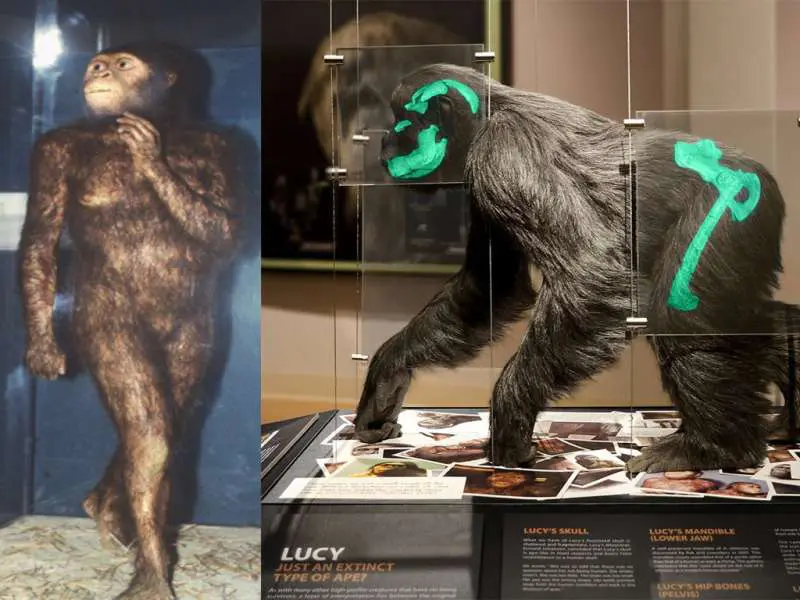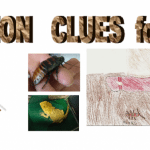A quick glance at your 6th-grade history textbook would lead you to believe that the question of our origin has been squarely resolved by evolutionary scientists. Pictures of hairy ‘ape-men’ are spread across the colorful pages of these textbooks, accompanied by confident declarations that we are, in fact, the descendants of the fossil ‘hominds’ (humans and their ape-like ‘relatives’) on which these illustrations are based.1

However, the track-record of evolutionary human origins research should prompt us to question the story we are currently being told about our ancestors in popular-science outlets like textbooks, magazines, museums, and TV shows.
In 1953, the scientific community came to the realization that their top evolutionary-icon, Piltdown Man, “discovered” in Britain in 1912, was actually a combination of human skull fragments and an orangutan jaw which had been doctored to look like ancient fossils and planted in a gravel pit. For nearly 40 years, Piltdown Man was used as the prime evidence that man evolved from ape-like creatures, yet it was an elaborate hoax.2
One may respond by pointing out that science is self-correcting, and that the Piltdown Man fraud was eventually exposed. Although this is ideally the case, there are two factors inherent in the search for human origins that inevitably lead to the making of numerous and serious errors, in some cases lasting for generations.
The first is an abundance of missing data. In the words of one well-known evolutionary researcher, “If you brought in a smart scientist from another discipline and showed him the meager evidence we’ve got, he’d surely say, ‘Forget it: there isn’t enough to go on.’”3 Others have expressed the same frustration, “Fossil evidence of human evolutionary history is fragmentary and open to interpretations.”4 Where there is a lack of evidence, speculation soon takes over. Indeed, a single bone can overturn decades of speculation,5 and speculation can turn a single tooth into an entire ape-man family!6
Interpretative bias is the second major factor at play in the search for human origins. When examining the reconstructions of a fossil ‘hominid’ from one museum display to another, you can often spot a number of differences. For example, some models of the famous fossil, Lucy, show her in an upright posture with short fur and ‘whites’ in her eyes in an attempt to make her look human. By contrast, the model of ‘Lucy’ at the Creation Museum looks just like another knuckle-walking ape. (See diagram)

Of course, the differences between models are due to different starting points. “Nobody looks at a fossil with a completely open mind. I suppose to some extent also we see what we think. So, you come to a fossil and you have an idea about the way you think human evolution worked, and the first thing you do is try and fit that fossil into your worldview.”7
Interpretations can and often do change. As documented in the cases of “Java Man,”8 “Nutcracker Man,”9 and the most-recent, “Ida,”10 discoveries in the field of human origins are often accompanied by much hype and fanfare (sometimes in spite of dissension from other scientists), only later to be quietly retracted. Currently, there is so much disagreement among scientists as to how the different ‘hominid’ fossils should be interpreted that some textbooks don’t even attempt to link them together!11 (See below)

In sum, when examining the currently-held (and ever-changing) fallible opinions of men and women, it would be wisest to listen and heed the words of Scripture:
“The one who states his case first seems right, until the other comes and examines him.” – Proverbs 18:17 (ESV)
“Test all things; hold fast what is good.” – 1 Thessalonians 5:21 (NKJV)
Free Resources for Further Learning:
Are There Apemen in Your Ancestry?
Video – “Did Humans Really Evolve from Apelike Creatures?”
Video – Ape-Men: The Grand Illusion
Bibliography:
1Frey, Wendy, John Bergez, and Amy Joseph. History Alive!: The Ancient World. Palo Alto, CA: Teachers’ Curriculum Institute, 2004. 5-22. Print.
2Wieland, Carl, Don Batten, Robert W. Carter, Jonathan D. Sarfati, Emil Silvestru, Tas Walker, James F. A. Mason, John Hartnett, David Catchpoole, and Mark Harwood. “Chapter 4: The Fossil Record.” Evolution’s Achilles’ Heels. Powder Springs, GA: Creation Book, 2014. 146-148. Print.
3Dailymail.com, Ellie Zolfagharifard For. “The 1.85 Million-year-old Little Finger Bone That Could Rewrite Human Evolution: Find Suggests Previously Unknown ‘giant’ Ancestors That May Have Used Tools.” Mail Online. Associated Newspapers, 19 Aug. 2015. Web. 05 Sept. 2015.
4David Pilbeam, quoted in Richard E. Leakey, The Making of Mankind. London: Michael Joseph, 1981. 43. Print.
5Henry Gee, “Paleontology: Return to the planet of the apes.” Nature, Vol. 412, 12 July 2001, p. 131.
6Wieland, et al. Evolution’s Achilles’ Heels. 146-148.
7Enigma Man: A Stone Age Mystery, Australian TV documentary. See Grigg, R., Enigma Man: A Stone-age Mystery, July 2014.
8Marvin Lubenow, Bones of Contention (Grand Rapids, MI: Baker Books, 1992): 86-99.
9Ibid, 157-158.
10“Ida (Darwinius Masillae): The Real Story of This “Scientific Breakthrough”” Answers in Genesis. Answers in Genesis, 21 May 2009. Web. 11 Oct. 2015. <https://answersingenesis.org/missing-links/ida-darwinius-masillae-real-story/>.
11Miller, Kenneth R., and Joseph S. Levine. Miller & Levine Biology. Boston, MA: Pearson, 2006. 770. Print.







